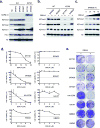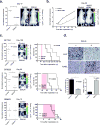Pharmacologic inhibition of histone demethylation as a therapy for pediatric brainstem glioma
- PMID: 25401693
- PMCID: PMC4257862
- DOI: 10.1038/nm.3716
Pharmacologic inhibition of histone demethylation as a therapy for pediatric brainstem glioma
Abstract
Pediatric brainstem gliomas often harbor oncogenic K27M mutation of histone H3.3. Here we show that GSKJ4 pharmacologic inhibition of K27 demethylase JMJD3 increases cellular H3K27 methylation in K27M tumor cells and demonstrate potent antitumor activity both in vitro against K27M cells and in vivo against K27M xenografts. Our results demonstrate that increasing H3K27 methylation by inhibiting K27 demethylase is a valid therapeutic strategy for treating K27M-expressing brainstem glioma.
Figures


Comment in
-
An epigenetic therapy for diffuse intrinsic pontine gliomas.Nat Med. 2014 Dec;20(12):1378-9. doi: 10.1038/nm.3769. Nat Med. 2014. PMID: 25473916
-
Cancer. For pediatric glioma, leave no histone unturned.Science. 2014 Dec 19;346(6216):1458-9. doi: 10.1126/science.aaa3814. Science. 2014. PMID: 25525232 No abstract available.
References
-
- Schwartzentruber J, et al. Driver mutations in histone H3.3 and chromatin remodeling genes in paediatric glioblastoma. Nature. 2012;482:226–231. - PubMed
-
- Bender S, et al. Reduced H3K27me3 and DNA Hypomethylation Are Major Drivers of Gene Expression in K27M Mutant Pediatric High-Grade Gliomas. Cancer Cell. 2013;24:660–672. - PubMed
Publication types
MeSH terms
Substances
Associated data
- Actions
Grants and funding
LinkOut - more resources
Full Text Sources
Other Literature Sources
Molecular Biology Databases
Research Materials

